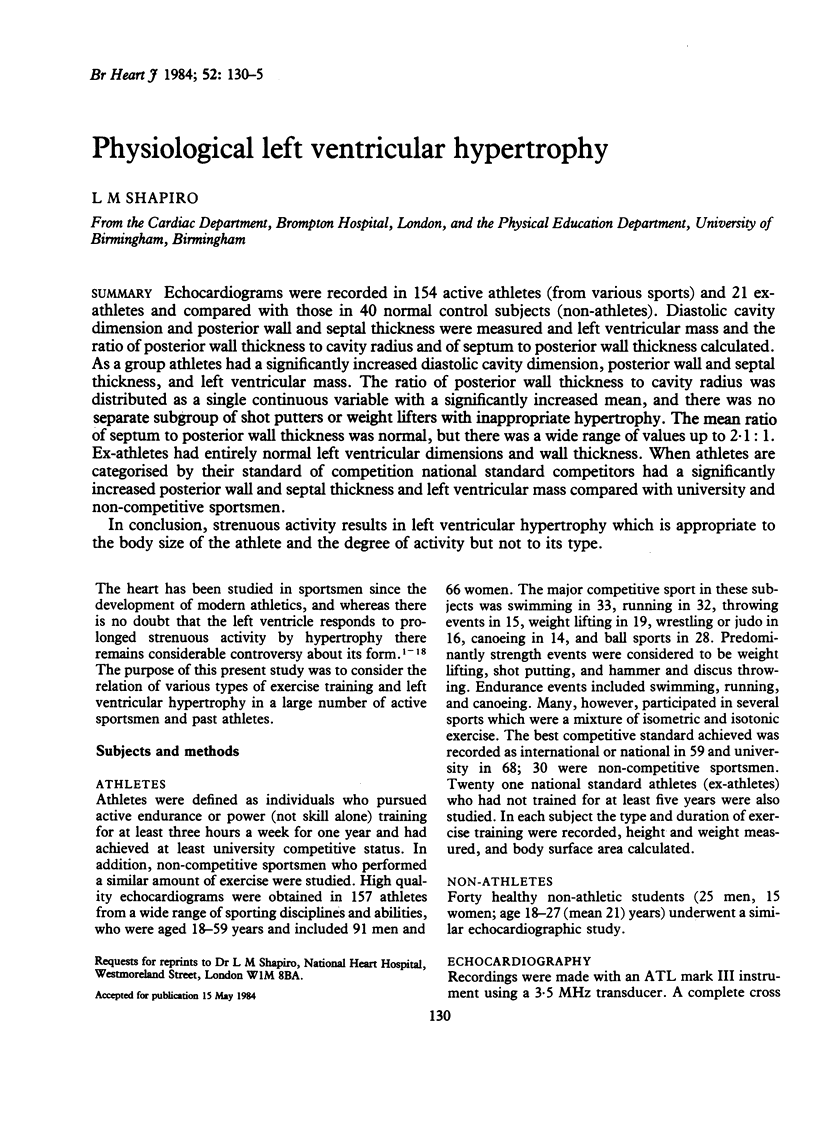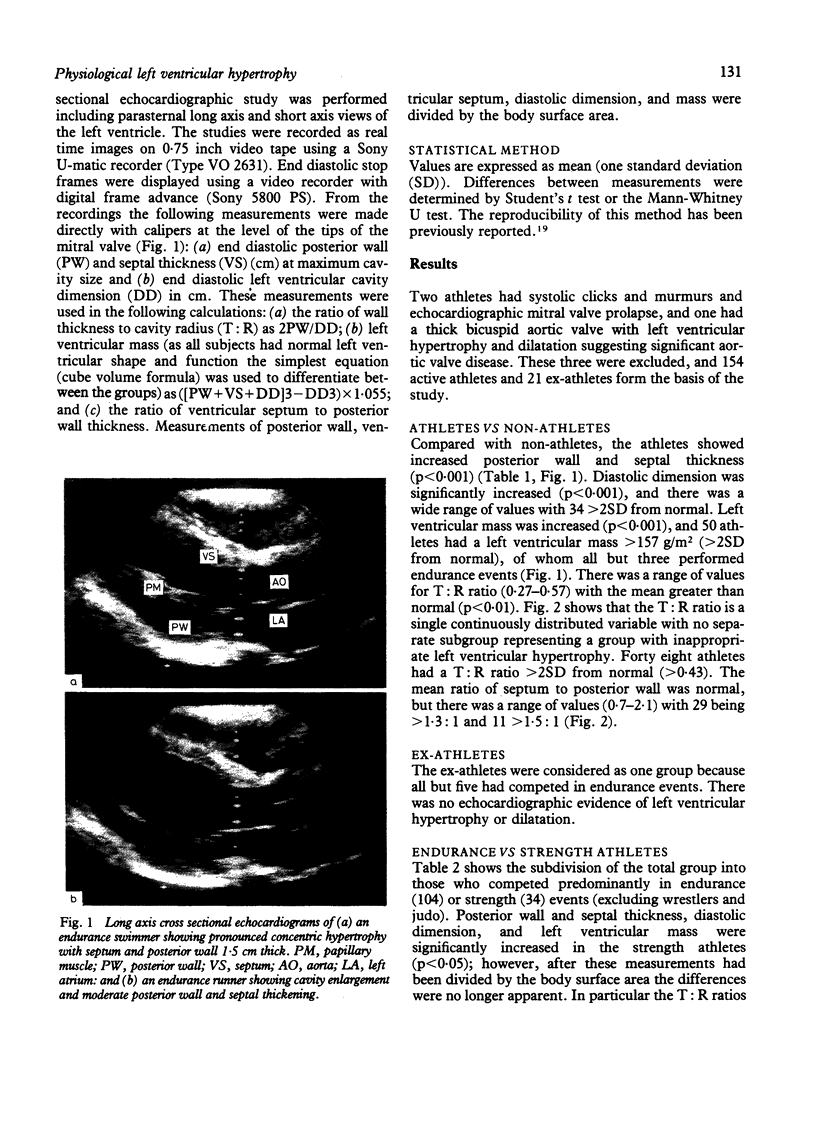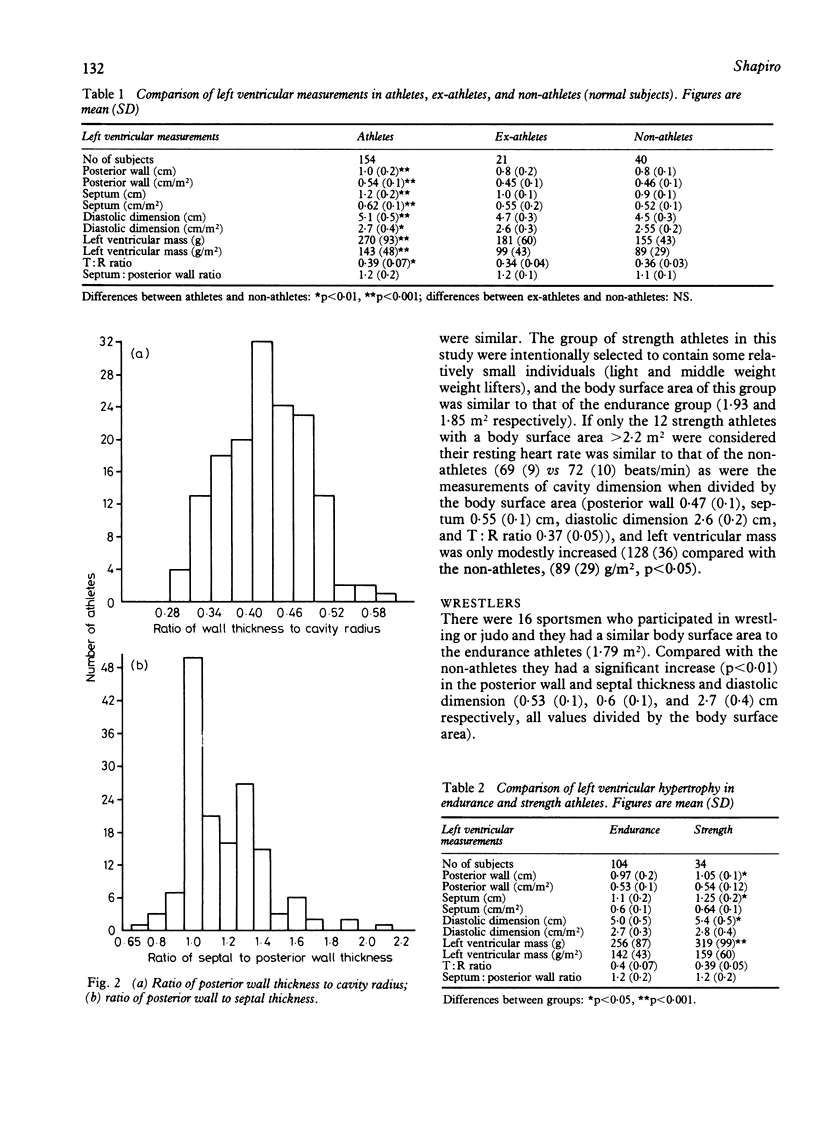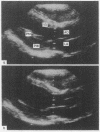Abstract
Echocardiograms were recorded in 154 active athletes (from various sports) and 21 ex-athletes and compared with those in 40 normal control subjects (non-athletes). Diastolic cavity dimension and posterior wall and septal thickness were measured and left ventricular mass and the ratio of posterior wall thickness to cavity radius and of septum to posterior wall thickness calculated. As a group athletes had a significantly increased diastolic cavity dimension, posterior wall and septal thickness, and left ventricular mass. The ratio of posterior wall thickness to cavity radius was distributed as a single continuous variable with a significantly increased mean, and there was no separate subgroup of shot putters or weight lifters with inappropriate hypertrophy. The mean ratio of septum to posterior wall thickness was normal, but there was a wide range of values up to 2.1:1. Ex-athletes had entirely normal left ventricular dimensions and wall thickness. When athletes are categorised by their standard of competition national standard competitors had a significantly increased posterior wall and septal thickness and left ventricular mass compared with university and non-competitive sportsmen. In conclusion, strenuous activity results in left ventricular hypertrophy which is appropriate to the body size of the athlete and the degree of activity but not to its type.
Full text
PDF





Images in this article
Selected References
These references are in PubMed. This may not be the complete list of references from this article.
- Adams T. D., Yanowitz F. G., Fisher A. G., Ridges J. D., Lovell K., Pryor T. A. Noninvasive evaluation of exercise training in college-age men. Circulation. 1981 Nov;64(5):958–965. doi: 10.1161/01.cir.64.5.958. [DOI] [PubMed] [Google Scholar]
- Bekaert I., Pannier J. L., Van de Weghe C., Van Durme J. P., Clement D. L., Pannier R. Non-invasive evaluation of cardiac function in professional cyclists. Br Heart J. 1981 Feb;45(2):213–218. doi: 10.1136/hrt.45.2.213. [DOI] [PMC free article] [PubMed] [Google Scholar]
- Cohen J. L., Gupta P. K., Lichstein E., Chadda K. D. The heart of a dancer: noninvasive cardiac evaluation of professional ballet dancers. Am J Cardiol. 1980 May;45(5):959–965. doi: 10.1016/0002-9149(80)90163-0. [DOI] [PubMed] [Google Scholar]
- DeMaria A. N., Neumann A., Lee G., Fowler W., Mason D. T. Alterations in ventricular mass and performance induced by exercise training in man evaluated by echocardiography. Circulation. 1978 Feb;57(2):237–244. doi: 10.1161/01.cir.57.2.237. [DOI] [PubMed] [Google Scholar]
- Fagard R., Aubert A., Lysens R., Staessen J., Vanhees L., Amery A. Noninvasive assessment of seasonal variations in cardiac structure and function in cyclists. Circulation. 1983 Apr;67(4):896–901. doi: 10.1161/01.cir.67.4.896. [DOI] [PubMed] [Google Scholar]
- Ford L. E. Heart size. Circ Res. 1976 Sep;39(3):297–303. doi: 10.1161/01.res.39.3.297. [DOI] [PubMed] [Google Scholar]
- Gaasch W. H. Left ventricular radius to wall thickness ratio. Am J Cardiol. 1979 Jun;43(6):1189–1194. doi: 10.1016/0002-9149(79)90152-8. [DOI] [PubMed] [Google Scholar]
- Gibson D. G., Traill T. A., Hall R. J., Brown D. J. Echocardiographic features of secondary left ventricular hypertrophy. Br Heart J. 1979 Jan;41(1):54–59. doi: 10.1136/hrt.41.1.54. [DOI] [PMC free article] [PubMed] [Google Scholar]
- Gilbert C. A., Nutter D. O., Felner J. M., Perkins J. V., Heymsfield S. B., Schlant R. C. Echocardiographic study of cardiac dimensions and function in the endurance-trained athlete. Am J Cardiol. 1977 Oct;40(4):528–533. doi: 10.1016/0002-9149(77)90067-4. [DOI] [PubMed] [Google Scholar]
- Grossman W. Cardiac hypertrophy: useful adaptation or pathologic process? Am J Med. 1980 Oct;69(4):576–584. doi: 10.1016/0002-9343(80)90471-4. [DOI] [PubMed] [Google Scholar]
- Henry W. L., Clark C. E., Epstein S. E. Asymmetric septal hypertrophy. Echocardiographic identification of the pathognomonic anatomic abnormality of IHSS. Circulation. 1973 Feb;47(2):225–233. doi: 10.1161/01.cir.47.2.225. [DOI] [PubMed] [Google Scholar]
- Ikäheimo M. J., Palatsi I. J., Takkunen J. T. Noninvasive evaluation of the athletic heart: sprinters versus endurance runners. Am J Cardiol. 1979 Jul;44(1):24–30. doi: 10.1016/0002-9149(79)90246-7. [DOI] [PubMed] [Google Scholar]
- Longhurst J. C., Kelly A. R., Gonyea W. J., Mitchell J. H. Echocardiographic left ventricular masses in distance runners and weight lifters. J Appl Physiol Respir Environ Exerc Physiol. 1980 Jan;48(1):154–162. doi: 10.1152/jappl.1980.48.1.154. [DOI] [PubMed] [Google Scholar]
- Maron B. J., Epstein S. E., Roberts W. C. Hypertrophic cardiomyopathy: a common cause of sudden death in the young competitive athlete. Eur Heart J. 1983 Nov;4 (Suppl F):135–144. doi: 10.1093/eurheartj/4.suppl_f.135. [DOI] [PubMed] [Google Scholar]
- Morganroth J., Maron B. J., Henry W. L., Epstein S. E. Comparative left ventricular dimensions in trained athletes. Ann Intern Med. 1975 Apr;82(4):521–524. doi: 10.7326/0003-4819-82-4-521. [DOI] [PubMed] [Google Scholar]
- Nishimura T., Yamada Y., Kawai C. Echocardiographic evaluation of long-term effects of exercise on left ventricular hypertrophy and function in professional bicyclists. Circulation. 1980 Apr;61(4):832–840. doi: 10.1161/01.cir.61.4.832. [DOI] [PubMed] [Google Scholar]
- Roeske W. R., O'Rourke R. A., Klein A., Leopold G., Karliner J. S. Noninvasive evaluation of ventricular hypertrophy in professional athletes. Circulation. 1976 Feb;53(2):286–291. doi: 10.1161/01.cir.53.2.286. [DOI] [PubMed] [Google Scholar]
- Roskamm H., Wink K., Reindell H. Die Arbeitsweise des Herzens bei chronischer physiologischer Mehrbelastung (Sportherz. Med Klin. 1972 Sep 1;67(35):1097–1103. [PubMed] [Google Scholar]
- Rost R. The athlete's heart. Eur Heart J. 1982 Apr;3 (Suppl A):193–198. doi: 10.1093/eurheartj/3.suppl_a.193. [DOI] [PubMed] [Google Scholar]
- Shapiro L. M., McKenna W. J. Distribution of left ventricular hypertrophy in hypertrophic cardiomyopathy: a two-dimensional echocardiographic study. J Am Coll Cardiol. 1983 Sep;2(3):437–444. doi: 10.1016/s0735-1097(83)80269-1. [DOI] [PubMed] [Google Scholar]
- Shapiro L. M., Smith R. G. Effect of training on left ventricular structure and function. An echocardiographic study. Br Heart J. 1983 Dec;50(6):534–539. doi: 10.1136/hrt.50.6.534. [DOI] [PMC free article] [PubMed] [Google Scholar]
- Stein R. A., Michielli D., Diamond J., Horwitz B., Krasnow N. The cardiac response to exercise training: echocardiographic analysis at rest and during exercise. Am J Cardiol. 1980 Aug;46(2):219–225. doi: 10.1016/0002-9149(80)90061-2. [DOI] [PubMed] [Google Scholar]
- Sugishita Y., Koseki S., Matsuda M., Yamaguchi T., Ito I. Myocardial mechanics of athletic hearts in comparison with diseased hearts. Am Heart J. 1983 Feb;105(2):273–280. doi: 10.1016/0002-8703(83)90527-6. [DOI] [PubMed] [Google Scholar]
- Wieling W., Borghols E. A., Hollander A. P., Danner S. A., Dunning A. J. Echocardiographic dimensions and maximal oxygen uptake in oarsmen during training. Br Heart J. 1981 Aug;46(2):190–195. doi: 10.1136/hrt.46.2.190. [DOI] [PMC free article] [PubMed] [Google Scholar]
- Wikman-Coffelt J., Parmley W. W., Mason D. T. The cardiac hypertrophy process. Analyses of factors determining pathological vs. physiological development. Circ Res. 1979 Dec;45(6):697–707. doi: 10.1161/01.res.45.6.697. [DOI] [PubMed] [Google Scholar]



